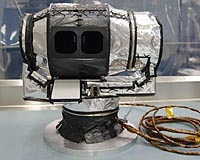 |
Moffett Field CA (SPX) Jun 25, 2009 The Lunar Crater Observation and Sensing Satellite, or LCROSS, successfully completed its most significant early mission milestone Tuesday with a lunar swingby and calibration of its science instruments. The satellite will search for water ice in a permanently shadowed crater at the moon's south pole. With the assist of the moon's gravity, LCROSS and its attached Centaur booster rocket successfully entered into polar Earth orbit at 6:20 a.m. PDT on June 23. The maneuver puts the spacecraft and Centaur on course for a pair of impacts near the moon's south pole on Oct. 9. "The successful completion of the LCROSS swingby proves the science instruments are functioning as expected. It is a testament to the hard work and dedication of the entire team" said Dan Andrews, LCROSS project manager at NASA's Ames Research Center at Moffett Field, Calif. "We are elated at the results from the maneuver and eagerly anticipate the impacts in early October." During its swing by the moon, the spacecraft's instruments were turned on and calibrated by scanning three sites on the lunar surface. These sites were the craters Mendeleev, Goddard C and Giordano Bruno. They were selected because they offer a variety of terrain types, compositions and illumination conditions. The spacecraft also scanned the lunar horizon to confirm its instruments are aligned in preparation for observing the Centaur's debris plume. "Each instrument returned good data that the science team will spend the next few weeks analyzing," said Anthony Colaprete, LCROSS project scientist at Ames. "These data will ensure we are as prepared as possible for monitoring and interpreting data we receive during impact." LCROSS and its attached Centaur upper stage rocket are now in a long, looping polar orbit around Earth and the moon. Each orbit will be roughly perpendicular to the moon's orbit around Earth and take about 37 days to complete. Before impact, the spacecraft and Centaur will make approximately three orbits. LCROSS and the Centaur separately will collide with the moon at approximately 7:30 a.m. EDT on Oct. 9, creating a pair of debris plumes that will be analyzed for the presence of water ice or water vapor, hydrocarbons and hydrated materials. The spacecraft and Centaur are targeted to impact the moon's south pole near the Cabeus region. The exact target crater will be identified 30 days before impact, after considering information collected by NASA's Lunar Reconnaissance Orbiter and observatories on Earth. Nine hours before impact, about 54,000 miles above the surface, LCROSS and the Centaur will separate. LCROSS will spin 180 degrees to turn its science payload toward the moon and fire thrusters to create distance from the Centaur. The spacecraft will observe the flash from the Centaur's impact and fly through the debris plume. Data will be collected and streamed to Earth for analysis. Four minutes later, LCROSS also will impact, creating a second debris plume. Share This Article With Planet Earth
Related Links LCROSS Mars News and Information at MarsDaily.com Lunar Dreams and more
 Diviner is ready to start lunar mapping
Diviner is ready to start lunar mappingPasadena, Calif. (UPI) Jun 24, 2009 The U.S. space agency's Diviner, an instrument that will map the moon's temperature, has entered a lunar orbit aboard NASA's Lunar Reconnaissance Orbiter. The instrument, a nine-channel radiometer built and managed by NASA's Jet Propulsion Laboratory, will also, for the first time, produce a map showing the composition of the moon, as well as a map showing how rocky the moon is. ... read more |
|
| The content herein, unless otherwise known to be public domain, are Copyright 1995-2009 - SpaceDaily. AFP and UPI Wire Stories are copyright Agence France-Presse and United Press International. ESA Portal Reports are copyright European Space Agency. All NASA sourced material is public domain. Additional copyrights may apply in whole or part to other bona fide parties. Advertising does not imply endorsement,agreement or approval of any opinions, statements or information provided by SpaceDaily on any Web page published or hosted by SpaceDaily. Privacy Statement |